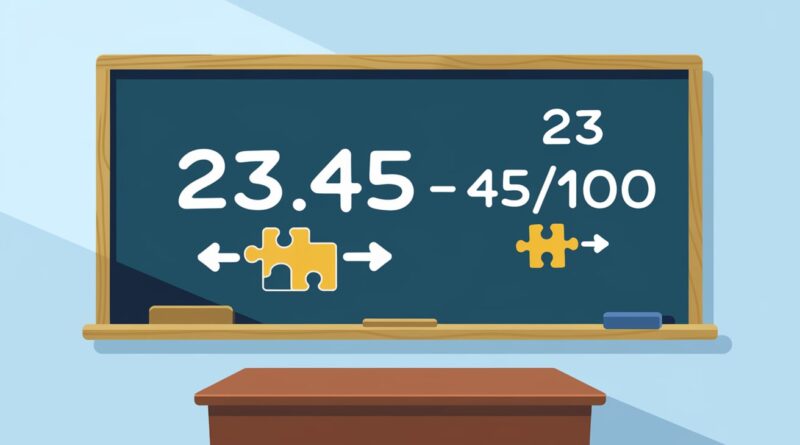Convert 10.9756097561 as a Fraction or Mixed Number – Complete Guide with Examples
Decimals often seem like an enigma, especially when you come across one like 10.9756097561. It’s not just any decimal—it’s a number that could potentially trip you up if you’re not familiar with how to convert it into a fraction or mixed number.
So why is this important? Whether you’re working on homework, trying to understand certain real-world applications, or simply curious about the magic of numbers, converting decimals to fractions is a skill everyone should master. The process is straightforward, and the results can be surprisingly useful in everyday life.
In this article, we’ll walk you through the step-by-step process of converting 10.9756097561 as a fraction or mixed number, discuss why this knowledge matters, and even touch on some advanced concepts related to decimal conversions.
Understanding Decimals and Fractions
Before diving into the conversion process, it’s important to understand what decimals and fractions are and why the conversion is necessary.
What Are Decimals?
Decimals are numbers expressed in a base 10 system, using a decimal point to separate the whole number part from the fractional part. For example, in 10.9756097561, 10 is the whole number, and 0.9756097561 is the decimal part. This decimal part represents a fraction of the whole number.
What Are Fractions?
A fraction represents a part of a whole. It is written as one number (the numerator) over another number (the denominator). For instance, 1/2, 3/4, and 5/8 are all fractions. Fractions are often used to represent parts of a quantity, making them incredibly useful in practical scenarios like cooking, measuring, and dividing resources.
Why Convert Decimals to Fractions?
You might wonder, why not just leave numbers as decimals? While decimals are easy to use in many situations, fractions offer a level of precision that decimals sometimes lack. For example, in certain contexts like engineering, cooking, or finance, fractions provide exact measurements and values, avoiding rounding errors that can occur with decimals.
Converting decimals to fractions or mixed numbers can also help simplify complex calculations. For example, if you’re dividing resources in a group project or calculating exact quantities for a recipe, fractions are often more useful and precise.
Step-by-Step Guide to Converting 10.9756097561 to a Fraction
Now that we’ve covered the basics, let’s dive into the conversion process. We’ll take 10.9756097561 and break it down into its fractional and mixed number form.
Step 1: Separate the Whole Number and Decimal
The first step in the conversion process is to separate the whole number from the decimal part. In 10.9756097561, the whole number is 10. This is the easy part, as we simply write it down and move on to the decimal.
Step 2: Convert the Decimal Part (0.9756097561) to a Fraction
Now, we’ll focus on the decimal part of the number: 0.9756097561. To convert a decimal into a fraction, we multiply both the numerator and denominator by a power of 10 that eliminates the decimal point.
Substep 2A: Eliminate the Decimal
We need to move the decimal point 10 places to the right, turning 0.9756097561 into 9756097561. To do this, we multiply both the numerator and the denominator by 10^10 (10,000,000,000).
0.9756097561=9756097561/10000000000
Substep 2B: Simplify the Fraction
Now that we have 9756097561/10000000000, we need to simplify the fraction. To simplify a fraction, we find the Greatest Common Divisor (GCD) of the numerator and denominator and divide both by that number.
In this case, the GCD is 1, so the fraction is already in its simplest form.
Thus, the decimal 0.9756097561 becomes 9756097561/10000000000.
Step 3: Combine the Whole Number and Fraction
At this point, we have two components:
- The whole number: 10
- The fraction: 9756097561/10000000000
To form a mixed number, we combine these two parts:
10+(9756097561/10000000000) = 10(9756097561/10000000000)
Therefore, the decimal 10.9756097561 is now expressed as the mixed number:
10(9756097561/10000000000)
Why Converting Decimals to Mixed Numbers Makes Sense
So, why would you bother converting 10.9756097561 into a mixed number rather than leaving it as a decimal? Here are a few reasons:
Simplifying Real-Life Problems
In many real-life scenarios, converting decimals to mixed numbers makes calculations easier and more intuitive. For instance, when dividing a pizza among a group of people, expressing the result as a fraction or mixed number can avoid unnecessary decimal approximations.
Fractional Precision
Fractions give us exact values, unlike decimals, which often need to be rounded. If you’re working on a project that requires precision, such as cooking or construction, fractions help ensure there’s no ambiguity or rounding error.
Mathematical Clarity
Mixed numbers also help present results clearly. Instead of saying “10.98,” you can say “10 and 99/100,” which makes the value more understandable, especially in educational settings or during detailed calculations.
Advanced Insights: Dealing with Complex Decimals
What if you encounter a decimal like 10.9876543210 or a repeating decimal like 0.3333…? Here’s how to handle them.
Decimals with More Digits
When decimals have more digits, the process remains the same. Simply multiply by a power of 10 large enough to move the decimal point to the right, and then simplify the resulting fraction.
For example, if you had 10.9876543210, you’d multiply both the numerator and denominator by 10^10 to eliminate the decimal and simplify as needed.
Repeating Decimals
For repeating decimals, like 0.3333…, there’s a special technique for converting them into fractions. You set up an equation, subtract the original from the equation after shifting the decimal, and solve for the fraction.
Simplifying Fractions: A Deep Dive
Once you have the fraction, you may need to simplify it. Simplification is an important part of working with fractions.
How to Simplify Fractions
To simplify a fraction, divide both the numerator and denominator by their Greatest Common Divisor (GCD). This process can make calculations easier and ensure the fraction is in its simplest form.
Example
If you have a fraction like 14/28, divide both by 14 to get the simplified fraction 1/2.
Visualizing the Process
A visual aid can make the process of converting decimals to fractions much clearer. Consider a diagram showing how the decimal 0.9756097561 translates into the fraction 9756097561/10000000000. Using visuals can help solidify the concept.
FAQs About Converting 10.9756097561 as a fraction or mixed number
Q: Can I Just Round 10.9756097561 to 11?
Yes, if you’re looking for a quick estimate, rounding is fine. However, for more precise work, it’s better to convert the decimal into a fraction or mixed number.
Q: How Do I Convert Repeating Decimals?
For repeating decimals like 0.3333…, you can use algebraic methods to convert them into fractions. The key is setting up equations that help you eliminate the repeating part.
Q: Why Is This Conversion Important in Real Life?
Understanding how to convert decimals to fractions is useful in everyday tasks like cooking, measuring, and handling money. It also comes in handy in more technical fields like engineering and construction.
Conclusion:
Converting 10.9756097561 as a fraction or mixed number is a valuable skill that helps in both academic and real-life situations. Now that you know the steps, you can easily tackle any similar decimal and convert it with confidence.
The next time you encounter a challenging decimal, don’t hesitate to apply the steps in this guide. You’ve got this!

